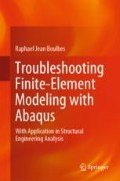Abstract
One of the main troubleshooting issues to deal with involves the material properties and definition of nonlinearity after the elastic behavior. In this chapter, details of large strain connected with the material law of behavior, especially, those used for hyperelasticity and rubber materials are given. The user will also find useful informations when the material definition is coupled with the User Material (UMAT) file to establish the correct settings or debugging protocol. The classic basis of a viscoelastic–plastic material behavior is still explained with a simple uniaxial stress versus strain curve, in order to prevent the reader from becoming overloaded by too many theory details, for instance, those available inside theoretical Abaqus documentation.
Access this chapter
Tax calculation will be finalised at checkout
Purchases are for personal use only
Notes
- 1.
In mathematics, a monotonic function (or monotone function) is a function between ordered sets that preserves or reverses the given order. This concept first arose in calculus, and was later generalized to the more abstract setting of order theory.
- 2.
A complement of information about the usage of hyperelastic materials can be found in the Abaqus Analysis User’s Guide in Sect. 22.5 Hyperelasticity.
- 3.
In continuum mechanics, objective stress rates are time derivatives of stress that do not depend on the frame of reference [3]. The Jaumann rate of the Cauchy stress is a further specialization of the Lie derivative (Truesdell rate). For this rate, \(\omega \) is the spin tensor (the skew part in Eq. 4.3 of the velocity gradient) as follows:
$$\begin{aligned} \tilde{\sigma } = \dot{\sigma } + \sigma .\omega - \omega .\sigma \end{aligned}$$(5.14)Many constitutive equations are designed in the form of a relation between a stress rate and a strain rate (or the rate of deformation tensor). The mechanical response of a material should not depend on the frame of reference. In other words, material constitutive equations should be frame indifferent (objective). If the stress and strain measures are material quantities then objectivity is automatically satisfied. However, if the quantities are spatial, then the objectivity of the stress rate is not guaranteed even if the strain rate is objective.
- 4.
See Abaqus Theory Guide v6.14 in Sect. 4.6.2 Fitting of hyperelastic and hyperfoam constants.
- 5.
See Abaqus Theory Guide v6.14 in Sect. 4.6.3 Anisotropic hyperelastic material behavior.
- 6.
See Abaqus User Subroutines Reference Guide v6.14 Sect. 1.1.38 UHYPER User subroutine to define a hyperelastic material.
- 7.
See Abaqus User Subroutines Reference Guide v6.14 in Sect. 1.1.41 UMAT User subroutine to define a material’s mechanical behavior.
- 8.
See in Abaqus Theory Guide v6.14 in Sect. 3.2.2 Solid element formulation.
References
Treloar LRG (1975) The physics of rubber elasticity. Clarendon Press, Oxford, p 85
Ogden RW (1997) Non-linear elastic deformations. Dover Publications, New York, pp 101–103
Gurtin ME, Fried E, Anand L (2010) The mechanics and thermodynamics of continua. Cambridge University Press, Cambridge, p 151, 242
Bathe KJ (1996) Finite element procedures. Prentice-Hall, Upper Saddle River, p 612
Weber G, Anand L (1990) Finite deformation constitutive equations and a time integration procedure for isotropic, hyperelastic-viscoplastic solids. Comput Methods Appl Mech Eng 79:173–202
McKenna RF, Jordaan IJ, Xiao J (1990) Finite element modelling of the damage process in ice. In: ABAQUS users conference proceedings
Snyman MF, Mitchell GP, Martin JB (1991) The numerical simulation of excavations in deep level mining. In: ABAQUS users conference proceedings
HajAli RM, Pecknold DA, Ahmad MF (1993) Combined micromechanical and structural finite element analysis of laminated composites. In: ABAQUS users conference proceedings
Govindarajan RM, Aravas N (1993) Deformation processing of metal powders: cold and hot isostatic pressing. Private communication
Kalidindi SR, Anand L (1993) Macroscopic shape change and evolution of crystallographic texture in pre-textured FCC metals. Acta Metall
Hughes TJR, Winget J (1980) Finite rotation effects in numerical integration of rate constitutive equations arising in large deformation analysis. Int J Numer Methods Eng 15:1862–1867
Author information
Authors and Affiliations
Rights and permissions
Copyright information
© 2020 Springer Nature Switzerland AG
About this chapter
Cite this chapter
Boulbes, R.J. (2020). Materials. In: Troubleshooting Finite-Element Modeling with Abaqus. Springer, Cham. https://doi.org/10.1007/978-3-030-26740-7_5
Download citation
DOI: https://doi.org/10.1007/978-3-030-26740-7_5
Published:
Publisher Name: Springer, Cham
Print ISBN: 978-3-030-26739-1
Online ISBN: 978-3-030-26740-7
eBook Packages: EngineeringEngineering (R0)

